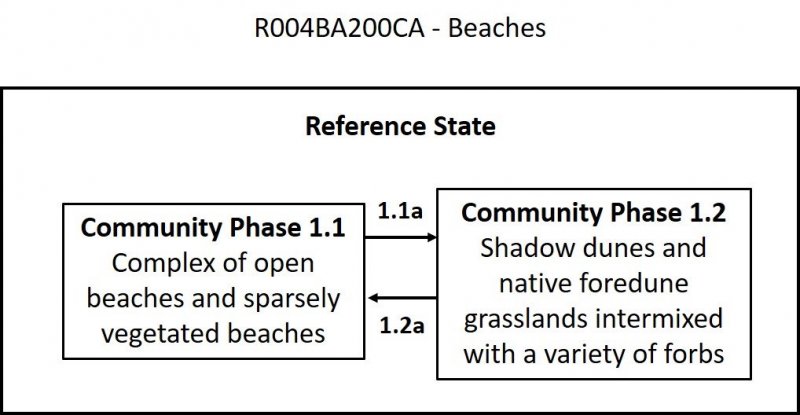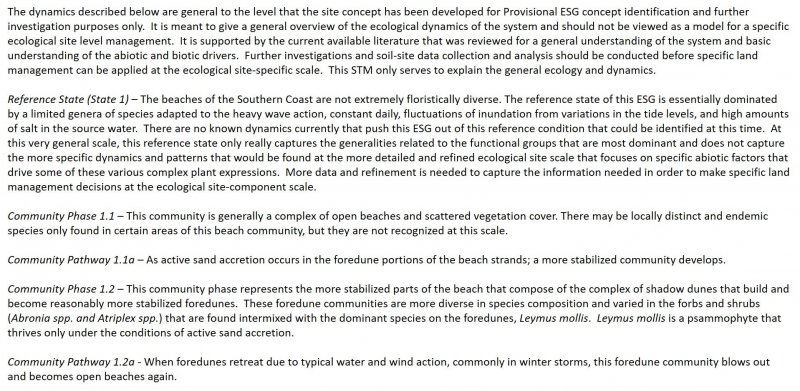Ecological site group R019XG902CA
Beaches
Last updated: 07/05/2023
Accessed: 12/21/2025
Ecological site group description
Key Characteristics
- located on beaches
Provisional. A provisional ecological site description has undergone quality control and quality assurance review. It contains a working state and transition model and enough information to identify the ecological site.
Physiography
This ESG is found on non-vegetated to slightly stabilized beaches and coastal strands. Elevations range from sea level to 10 feet, with slopes ranging from 0 to 5% typically.
Soil features
Soils will vary, but all will be salty coarse sands that are poorly drained and frequently flooded.
Soils associated with this ESG are Beaches components
Vegetation dynamics
Beaches represent the leading edge of terrestrial continental vegetation; a long, narrow, interrupted band that supports sparse, early successional plant cover that is often associated with the other ESGs typical of this area, the more rapidly changing beach dunelands. The extent of this ESG stretches from the mean tide line to the top of the foredune or farthest inland reach of storm waves. They may have incipient structural forms that are influenced by the vegetation, such as sand shadows and hummocks that have not coalesced into true dunes.
Abiotic Factors
Wave action, salt spray, soil salinity, sea-water immersion and sand movement are the most critical abiotic factors for this ESG, primarily in the context of geologic processes and coastline water and wind currents. The immediate forces of ocean waves as they meet the shoreline and inundate the surface have heavy impacts to the beach ecological site, depositing sediments and salt water daily and fluctuating the intensities and durations of the waves and tidal levels. This impact is a gradient from the immediate locations that are impacted by the waves, up to the portions where the wave waters end and recede.
The salt spray gradient is a function of wind speed, distance from the tide line, height above the ground, and microtopography. Hypertrophy (succulence) accounts for the ability of dicots to withstand salt spray, and grasses that lack this ability, rely on a thick cuticle instead. Salt spray tolerance dictates the species composition that dominates the different areas of this ecological site, but also impacts the structure of the vegetation expression as well. Although beach species are not obligate halophytes, they are tolerant of soil salinity and occasional seawater immersion. Germination and establishment phases of most beach species is when they are the most vulnerable to the soil salinity, and therefore depend on times that seawater immersion and impacts from salt water are minimal until after full establishment.
Primary Disturbances
Wave action from the ocean is the primary disturbance, however wind will also plays an important role. The constant impact from the ocean waves maintains a dynamic of barren sands and sparse vegetation cover that is able to withstand a rather constant daily fluctuations in inundation by salt water and high velocity wave actions. Water deposition, onshore winds, desiccation, nutrient limitations, and sand burial are all important disturbances that naturally drive the dynamics of this ecological site concept. Adaptations to sand burial are key adaptations for vegetation in this ecological site, developing larger, heavier seeds that have the ability to emerge from much greater depths once germinated. These species have also adapted to planting themselves deeper in the sands to take advantage of higher soil moisture content and protection from the wind/sea salt spray. Other adaptations include plant morphologies and canopy densities. Different accumulations of sands occur with different plant canopies, for example plants with intermediate canopy densities with loose, cylindrical silhouettes cause a decrease in wind velocities within the plant canopy leading to accretion of fine sands and the formation of hummocks typical of this ESG.
Desiccation is a major stressor to this ecological site, namely from intense solar radiation and evapotranspiration, seasonal drought, and low water-holding capacities of the sands typical of this ecological site. The species that dominate this ecological site are adapted to these conditions, using various rooting strategies, leaf morphologies that can withstand high levels of solar radiation, high light intensities for photosynthesis, and wind desiccation, and root and shoot strategies to ameliorate the low-fertility soil conditions.
Dune morphology begins when beaches with vegetation create shadow dunes or beach mounds. These shadow dunes occur when a plant causes wind to be deflected, slowing its speed and dropping sand particles into an elongated tongue of sand in the lee of obstacles. Changes in wind direction result in accumulations on all sides and the formation of a beach mound. These can be easily blown out by wind gusts or winter waves. However, when they are built on relatively wide areas of beach, a foredune can develop. A foredune is a vegetated ridge of sand parallel to the beach, rising above the ordinary high tides. These foredunes support greater species richness and plant cover than the upper beach, but fewer species that are found just inland on dune ridges.
This ESG includes these more incipient shadow dunes and the foredunes that are vegetated and stabilized. Since these shadow dunes and foredunes are both easily impacted by winter storm waves and heavy coastline winds, they are considered more a portion of this ecological site instead of the stabilized dune ecological site that has more distinct, stabilized vegetative cover and higher species diversity.
Major Land Resource Area
MLRA 019X
Southern California Coastal Plains and Mountains
Subclasses
Correlated Map Unit Components
23481971, 23477354, 22665503, 22666590, 22666487, 22670495, 22670670, 22670697, 22670932
Stage
Provisional
Contributors
Curtis Talbot
Click on box and path labels to scroll to the respective text.

